#it’s commonly used for funerals
Explore tagged Tumblr posts
Text

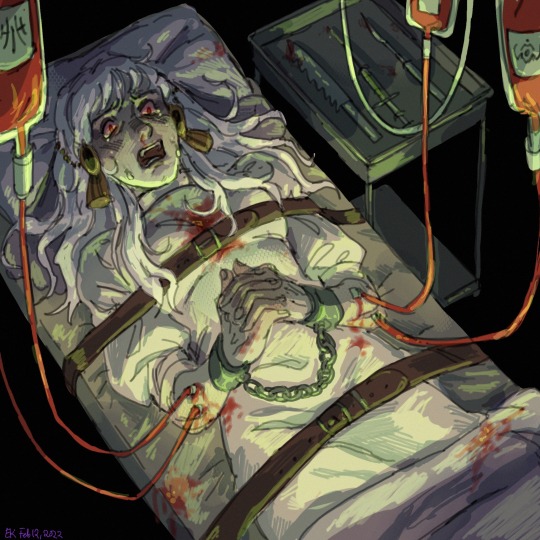
PLEASE DON’T LET ME DIE!
these r from 2022 omg almost 3 years old, I like to think I’ve improved since then but I still love these two T_T. I love that Lysithea looks like a lab test bunny and her favorite flowers are lilies, the ones most commonly used at funerals.
Original Instagram posts HERE and HERE
And a bonus redraw I did just now to see what it would look like lmao. Maybe one day.

#might redraw idk but they took so much work lmao#old art#fe3h#fire emblem three houses#lysithea von ordelia#fire emblem#fire emblem fanart#fire emblem heroes#fire emblem 3 houses#fire emblem 16#fe16
2K notes
·
View notes
Note
Would you mind giving some info/lore/creator’s notes on Lilith?
-Asmodeus's wife and queen of the lust ring
-Her outfit is based off of funeral attire and corpses. One of my favorite details about Lilith that I feel is pretty underutilized in fiction is the amount of death that surrounds her. there's a lot more focus on lust and trying to make her a feminist icon, when I find her vanity and the fact that she kills infants a lot more interesting.


-She's unable to have children of her own, so she views all demon children as her own. Succubi and Incubi especially view her as their own mother, since they're commonly abandoned at birth.
-She's the only human turned demon in all of Hell
-Similar to Lucifer, she has an intense hatred towards humanity and is often seen laughing and dancing whenever she sees violence and destruction.
-Unlike Lucifer though, she dislikes using demons for war.
-In fact, she doesn't even like Lucifer. She think he's selfish, arrogant and a terrible leader.
-Lilith has an intense dislike of men and views them as inferior to women. Even demon males are sometimes given the cold shoulder compared to female demons.
-Lilith views love the worst sin of all. All other sins are simple vices you can control, but love is uncontrollable, you can't suppress love. And that makes people do incredibly terrible things.
-She loves Asmodeus though :"D
1K notes
·
View notes
Text

carnations — mourning, grief, and sorrow; chrysanthemums — commonly used in funeral floral arrangements to say goodbye; apples — symbol of destruction.
prints + merch + dm for commission info
#vic.txt#my art#alicent hightower#aegon ii targaryen#hotd#house of the dragon#asoiaf art#asoiaf#a song of ice and fire#house hightower#house targaryen#art#fav#fanart#illustration#artists on tumblr#digital art#character art
2K notes
·
View notes
Text

4,000-Year-Old Tomb of Egyptian Royal Physician Found in Saqqara
Teti Neb Fu, a high-ranking physician during Pharaoh Pepi II's reign, held titles like Chief Dentist, Priest of Serket, and Director of Medicinal Plants.
In the southern region of the Saqqara archaeological site, a joint French-Swiss archaeological team made an important discovery uncovering the mastaba tomb of the royal physician Teti Neb Fu from the Old Kingdom, according to a statement by the Egyptian Ministry of Tourism and Antiquities.
This tomb, unearthed in the southern region of the archaeological site of Saqqara, known to contain the tombs of high-ranking officials from the Egyptian Old Kingdom, shows that medicine and magic were once equally revered, and expertise in both earned a long-dead physician to the pharaohs a place of honor among the ancient world’s most esteemed.
Dating back over 4,000 years to the reign of King Pepi II, this important find features exquisite carvings and vibrant artwork, including a painted false door and elaborate scenes depicting funeral offerings.
The sarcophagus found inside the tomb was also inscribed with the name of its occupant and his titles, according to the post. Because of the burial location in Saqqara, researchers knew he was important, but Teti Neb Fu’s official titles named him as the chief palace physician.
Teti Neb Fu, who held prestigious titles such as Chief Palace Physician, Chief Dentist, and Director of Medicinal Plants, also had a unique role as a “Magician” of the Goddess Serket, specializing in the treatment of venomous bites.

Additionally, he was known as the “Great Physician of Teeth” and “Director of Medicinal Plants”, suggesting that he led research and practical applications in the fields of dentistry and the use of therapeutic herbs.
Even though it had been looted in the past, the mastaba still has many of its ornamental features. The director of the archaeological mission, Dr. Philippe Collombert, said the walls are decorated with remarkable reliefs and inscriptions, including a complex frieze that displays the owner’s name and titles.
Among the most remarkable elements is the red-painted ceiling, which is intended to resemble granite blocks, a material commonly found in imposing buildings. The titles and name of the doctor are also written in the middle of the ceiling. An additional noteworthy discovery within the mastaba is a stone sarcophagus, which has hieroglyphic decorations inside that offer more information about Teti Neb Fu and his accomplishments.



Mohamed Ismail Khaled, secretary-general of Egypt’s Supreme Council of Antiquities, emphasized the importance of this discovery, stating that the texts and drawings on the tomb’s walls unveil new insights into the daily life of the Old Kingdom.
This discovery strengthens Saqqara’s position as one of Egypt’s most important historical sites and contributes to its rich archaeological legacy.
Excavations in this area of Saqarra began in 2022, to unearth the graves of state employees for King Pepi who are buried near him and his wives, officials said.
By Oguz Buyukyildirim.

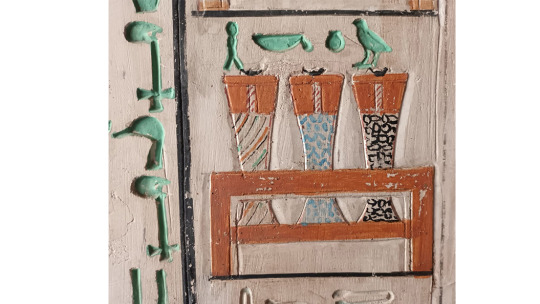

#4000-Year-Old Tomb of Egyptian Royal Physician Found in Saqqara#Saqqara#ancient tomb#ancient grave#ancient artifacts#archeology#archeolgst#history#history news#ancient history#ancient culture#ancient civilizations#ancient egypt#egyptian history#egyptian hieroglyphs#ancient art#Teti Neb Fu
753 notes
·
View notes
Text
The fandom glorifies Arthur Morgan
Now I am not talking about about low honor, I play high honor and got it as the top at the end of every damn playthrough but my Arthur, as it is the cannon Arthur, is not a good guy. I am not going to talk about all of the murder, robbing and stuff he does, because we are majorly aware of it, I am talking his sexism, casual ignorance and disrespecfulness.
I quite often see people say that Arthur Morgan is a woman lover, and he definitely is, he is better than a lot of men from that time (which isn't hard), but he would not hold up in modern times, because he is not from modern times.
Generally speaking, Arthur Morgan is a man who believes in gender roles, he believes in the idea of "a man being a man" and "a woman being a woman." He has opinions about what a woman should do and what a man should do.
I think the biggest hint at this is his relationship with Sadie, because while he accepts her running with the boys he doesn't seem entirely happy about it. "You got a pair of pants and all of a sudden you think you're Landon Ricketts?" "You want to ruuuunnnn with the men?" and also "can Ms Grimshaw spare you?" when the girls asks if they can come to Valentine with him.
Talking of that quest, when he runs off to get Jimmy Brooks he puts Uncle, a lazy old bastard, in charge of getting the girls home even though they are more than capable of doing it themselves as they are healthy young women who knows how to handle horses.
In several antagonize lines against women performers (which are just as cannon as his greet lines) he shouts things like "That isn't very ladylike!" or "Go back to the kitchen" and "go make someone supper."
People keep saying Arthur would "treat them right" and he would, to an extent, he would care for you, he would be nice to you, but he would force those gender roles. He does have a belief women are somehow "softer" and that he as a person with a provider gene should do more of the harsh work.
So now we covered that, lets talk about the racism, or as I probably should rather call it, ignorance, because it is very commonly know Arthur does not judge by the color of skin.
The first one is that Arthur uses the whites-only saloon in Rhodes. Tilly mentions it to Arthur that they don't allow people of color into it, and yet he still supports it, it isn't a big thing but it is something of notice.
Secondly, when he talks to Eagle Flies where he "sets him in his place" Arthur, honey, you are so wrong here. Eagle Flies is being chased by the government for the mere fact that he exists with a different culture, you are being chased because you murdered so many folks, you can run across the sea and live a good life, they are fucked regardless.
When we first arrive in Lemoyne, Lenny and Arthur talks about the Lemoyne Raiders about racism and Arthur says "These boys got a manner about them but I haven't particularly noticed," Arthur of course you wouldn't, you are a tall, muscular, white man with sun kissed hair and blue eyes, you are the poster boy for eugenics.
Lastly, which will also bring me to the third point, the casual disrespect:
Arthur causally calling Javier a slur on the boat for no reason, did you really need that one-liner so badly? That goes for a lot of times in the game such as: "are you secretly normal" "what a lunatic" "we should find a better story for that scar" "But you continue to irritate me, I will kill you and make my appologies to the lady" "stick around and you might die for her as well" "oh I didn't know I was talking to a lady." All those were a slight bit disrespectful, enough to be able to annoy the majority of us if he said it to us, and they were also unnecessary.
He is also canonically chronically late, most notably we can hear Sean saying "that man will be late to his own funeral," and when you go around antagonizing characters in camp they are not surprised at all, rather they go "back at it again huh?"
All of this is just to sum up, Arthur is a pretty bad man (also counting in all the illegal stuff) and we tend to glorify him and forget some of these things, partly is also because Rockstar are amazing at hiding them, at making them seem natural, and they are because this is a historically accurate game! It is set in 1899 and this is a man from 1899 he is going to be casually sexist and disrespectful, and again, considering that he is from 1899 he is a decent guy because the majority of folk would be like Micah, not Arthur.
I definitely love Arthur, and I love Arthur exactly because the point of his character is him not being a saint but a human. His redemption is choosing to do good where he can, but even so, this is a man in 1899 and he is going to have a 1899 mindset. If you want to play a game that is set in the past but don't have that type of accuracy it is not Red Dead you want to play.
Also here is an Arthur pic as a thank you for reading all of that. I love him.

#rdr2#rdr2 community#red dead redemption 2#arthur morgan#rdr2 arthur#john marston#rdr john#red dead redemption community#dutch van der linde#rdr2 john#character analysis#red dead redemption two#red dead fandom#nthspecialll
558 notes
·
View notes
Note
As you're THE local florist, I'd like to request some Baker!Nanami x Florist!Reader headcanons that come to your mind 🙂↕️♥️
the local florist??? i am blushing. you're so sweet ilysm mwah. so i obvi took some real life inspiration from my life. and as happy as i am to not work as a florist anymore (bc it's too much work for shit pay), i look back at it with fondness, and i think i love flowers more than the average person lol

baker!nanami and florist!reader, who have a shelf in the bathroom dedicated solely to hand moisturiser due to constant cracked and calloused hands — neither occupation is as delicate and nice as it might seem to be on the outside.
for nanami, kneading dough and rolling out pastry takes a toll on his strong hands, the pillows of his fingertips becoming rough after being stuck with said tasks for hours. for you, your hands turn dry after constantly working with water. they’re basically submerged in water half the time, constantly wetting and drying them which eventually leaves small cuts in your skin.
baker!nanami who accompanies florist!reader to the airport when you have to pick up the cut flowers that’s being delivered. the large boxes of flowers are a lot heavier than they look. this is where nanami comes in, who spends a lot of time carrying flour bags, so lifting a few boxes of flowers into your van is no problem at all.
baker!nanami who comes to your flower store after closing, because you have to work late — again. he usually clocks out by the time you lock up, and he always texts to hear if you have to stay longer, and about half of the time the answer is yes.
whether it be a wedding, funeral or just a celebration of some sort, the demand for flowers is high, and never underestimate the time it takes to put together a dozen table decorations.
but nanami will, sooner rather than later, knock softly on the window. you scurry over to let him into your dimly lit store, his available arm snaking around your waist to pull you close, placing a soft kiss on your temple. in his other arm he has brought dinner — if you can consider leftovers from the bakery dinner. you don’t mind though, because his bread and buns are delicious ;)
baker!nanami and florist!reader who have to do laundry every single day. when he returns home after a day of baking, he is covered in flour, and dough is still sticking to his clothes, while your clothes are stained with dirt — ungodly amounts of dirt, and you don’t understand where it all comes from.
baker!nanami and florist!reader's apartment is the place to hang out because it’s so extremely cozy. due to both of you being particularly meticulous when it comes to details, every inch of your home is carefully thought out.
from furnishing to decorations, there’s just a harmony throughout your home that is very warm and inviting, so people tend to want to stay there as long as possible.
baker!nanami who sends customers to your store, especially couples who are in to order wedding cakes. he will casually hold a conversation and sneak in the question of “have you fixed flowers yet?”, and just send them in your direction.
baker!nanami who scolds you for being too careless. a florist uses a great variation of tools in their work. most commonly is obviously the floral knife, which you might pave around a little too much. you can’t really help it as you value efficiency when the store is packed with demanding customers who want their bouquets yesterday.
so when you come home, the first thing he’ll do is examine your hands before shooting you a disappointed glare — “what about your burns, mister?” you’ll quip in return, because his hands are just as scarred as yours. he’ll answer the same thing every time; “you’re more important.”
baker!nanami and florist!reader who have an hour every night before bed, dedicated to venting about customer experiences from throughout the day.
“must be so cozy working here,” you both hear on a regular basis, but if they only knew. nanami often has to take a deep breath when people walk into the bakery asking “excuse me, do you sell pastries?” like there isn’t a display cabinet a few feet in front of them filled to the rim with delicious treats.
and you’ll tell him about the gossip you get an insight to. how you had to write a card from some guy to his girlfriend, or presumably former girlfriend now, where it said ‘i’m sorry i messed up again baby. i never meant to slip into her dms. you’re the best thing to ever happen to me, love your sugar plum’
baker!nanami and florist!reader who live the domestic dream. you spend your days doing what you love, always bringing your passions with you home — a home filled with both flowers and bread.

©hiraethwrote 2024 . all rights reserved. reposting, translating and otherwise plagarisim is prohibited
#— ଓ my creative corner#— my darling ꒰shikari꒱#dividers by cafekitsune#jjk#jjk x reader#jjk headcanons#jujutsu kaisen#jujutsu kaisen x reader#jujutsu kaisen headcanons#kento nanami#kento nanami x reader#kento nanami headcanons#nanami kento#jjk nanami#nanami x reader#kento x reader#jjk kento nanami#jjk kento
365 notes
·
View notes
Note
Anna!! Something I noticed and wanted to get you input, the scenes where Buck and Eddie were placing the flowers on the tables. Is there’s something to be said about Buck placing his yellow flowers on a tan/warm beige table mat versus Eddie placing is white flowers on a blue table(coffee table) mat?
the minute I noticed it after seeing a screenshot of the images next to eachother I thought hmm are those the colors Anna on tumblr is always mentioning buck and Eddie need to get to, ‘their’ colors 😅bucks blue and Eddie’s warm yellow: tan
Hi darling! Okay, I gotta be real with you, I don't know anything about flowers, I'm allergic to most of them, so I try to stay away, that being said, the colors did pique my interest, especially the ones Eddie puts down in the first scene. Because it's the arrangement with the most colors. I can't identify the flowers in this one tho, so I can't say anything besides I think it's interesting that it has so many colors, even if the yellow flowers are the thing that catches your eye first and he places it in the blue tray.

But the one Buck puts down and the one from the last scene are fun for a lot of reason I found out while googling compulsively about the meaning of flowers.

Talking about colors, the colors here are a lot more cohesive than Eddie's, even as far as matching the mat, but what caught my eye in this is the sunflower of it all, because most places you look for tell you sunflowers are about loyalty and admiration. And a lot of places I read talk about it as a flower to bring joy. Since it follows the sun, they also use it as a flower of hope. Which is kinda insane in the greater context of Eddie's plot and the role Buck has in his life, yk?

But the flowers in the last scene are the ones that drive me a bit insane.
White Roses: Purity and New Beginnings White roses are the lightest and brightest variation of these incredible blooms, which symbolize the genuine purity of love in all its forms. They are commonly used in grand gestures, such as proposals, weddings, and anniversaries, because of their unmistakable declaration of eternal love. White roses represent everlasting love, innocence, youthfulness, loyalty, purity, and new beginnings. Their romantic history shares an equally prominent somber parallel. White roses are often used to express remembrance in times of grief. Their bright color represents a ray of hope, acknowledging the blessings that lie just beyond the darkest times.
First of all, most wedding planning places will tell you to use a white rose bouquet at your wedding, and that arrangement lowkey looks like one (I got an ask about this, mentioning the wedding bouquet specifically but I can't find it again, but anon this one is also for you), but it is also a flower that can be used for funerals because they can also be a symbol of hope for the future in trying times, like, what? No matter how you look at those, they are a symbol of eternal love. They had Eddie put down the flowers of grand gestures as Buck pulled the ultimate grand gesture, and my brain lowkey stopped working.
They wanted us to pay attention to the flowers, it's part of the dialogue, and we get shots focused on them, so I'm kinda losing it a little bit, ngl. Why a symbol of eternal love that looks like a wedding bouquet???????????
113 notes
·
View notes
Text
Nonexhaustive list of creatures I don't think should be able to get compleated
Because it's been 2 years since MOM but I'm still critiquing the biology in it anyway
Spirits and other immaterial beings I firmly believe, and this was fairly consistent in canon until MOM, that Phyrexian oil works on two fronts: physical and mnemonic. That's it. The oil can convert tissues or metal that it physically touches, and it is a vehicle of information transfer that can bend minds toward whatever ideology is contained in it--i.e. the will of Yawgmoth or Elesh Norn. Canon used to be very specific that Phyrexian oil can convert metal to flesh and vice versa. Nothing in there about spiritual creatures--or the fabric of funeral shrouds, for that matter.


Elementals Similar reasoning. Elementals are made of neither metal nor flesh, and should not be able to get converted.


Aetherborn, Kaldheim changelings Listed together because I believe they are extremely similar subtypes of the same creature. Aetherborn are made of aether, and changelings are thought to be made of the stuff of the Cosmos--Kaldheim's local equivalent of the Blind Eternities. Just as Phyrexian oil is largely incompatible with the retention of the aether soul in a creature that is compleated, I can't imagine that it plays well with the physiology of a mostly-or-completely aether creature. There's a chance this was actually confirmed or hinted at in Consuming Aetherborn, though it's likely they weren't literally drinking Phyrexian oil. There are no Kaldheim changelings in MOM so at least I don't have that to pick on.


Cosmos monsters, eldrazi Like aetherborn and changelings, I am listing these together because I believe they are analogous, just on different scales (the planar/interrealm scale vs. the Multiversal scale). They are eldritch plane-eaters that exist in the space between realms/planes, which is commonly known as the Blind Eternities. Like aetherborn and changelings they are not truly physical beings but projections of the Eternities. They should not be able to get affected by Phyrexian oil.

Most gods Similar logic to those above, but with a significant exception. Gods that I think can get compleated are those 1) heavily influenced by mortal belief (Theros) or 2) those who are basically mortals but with magical augmentation (Kaldheim). These are affected by the mnemonic and physical axes of action of the Phyrexian oil, respectively. This is one thing that I actually think MOM did right in portraying Phyrexia's approach to Theros, though it would've also been wild and surprisingly plausible to see a Yawgmoth Resurrected.

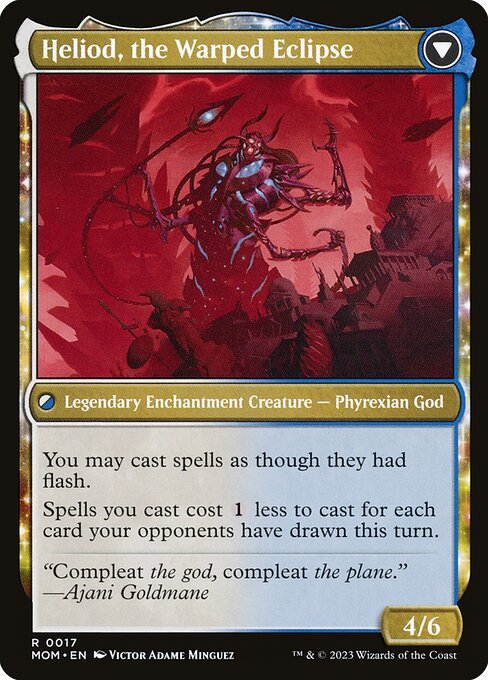
I'm withholding judgement on Capenna angels, because I don't know (and haven't speculated) enough about the actual biology of how their bodies produce and retain Halo, but this also does strike me as odd. I had always thought that Halo was some kind of angelic essence that could be extracted from the bodies of angels, and it "running out" doesn't make the most sense to me.

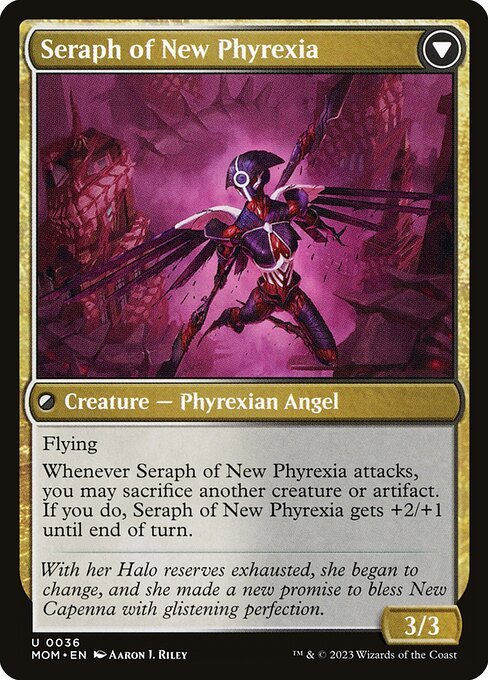
And then there are random, seemingly completely regular creatures that can resist--and enjoy consuming--Phyrexian oil. I have no explanation for this, but they seem to be having a pretty good time. Maybe Yargle is immaterial-spirit enough to resist it?
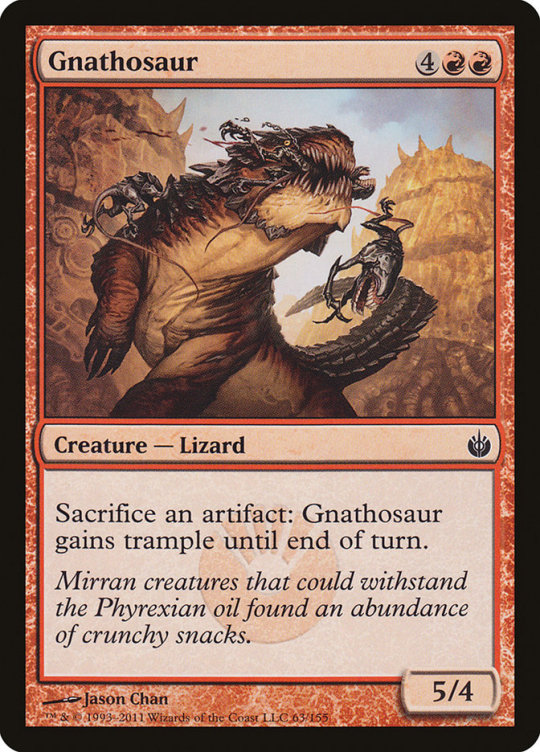
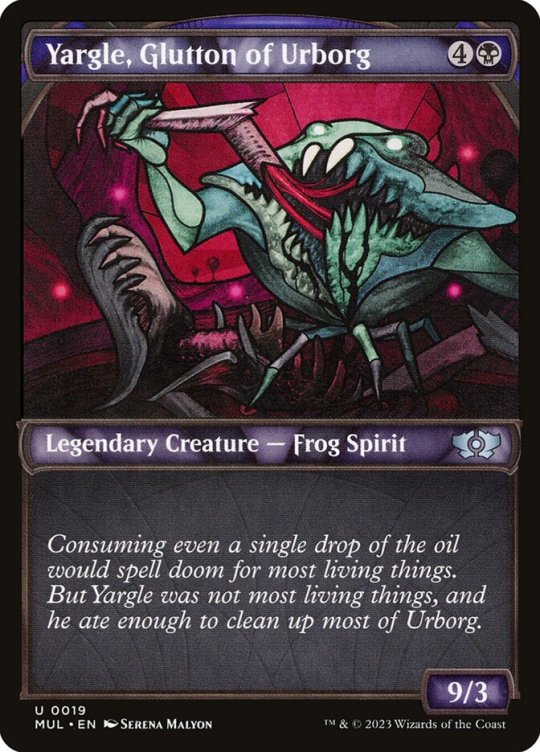
#mtg#magic the gathering#march of the machine#phyrexian#fantasy biology#new phyrexia#kaldheim#new capenna
106 notes
·
View notes
Text
02 Jealousy

Zhongli x Reader / SFW but suggestive at the end / Mentions of Childe / Set at the beginning of the Liyue archon quest / Reader is unaware that Zhongli is the Geo Archon
"My dear, is something on your mind?"
Perceptive as he was, Zhongli couldn't figure out what it was that was upsetting you. That pout on your lips had been plastered there for a while now and as many times as he had questioned you if anything was bothering you, you simply brushed it off.
"I'm fine." You were, or so you thought you should be.
Zhongli was a bit of an attention magnet, which was not surprising with the meticulous way he dressed, his exceptional knowledge, and the way he carried himself. He delighted in it, smiling and going about his day as if he were simply soaking in sunlight. You often found the consultant lost in long-winded conversations with random people on the streets. While you found the person's advances a bit pushy, Zhongli didn't seem to think much of it.
Suspicions prickled underneath your skin when Zhongli mentioned that the individual had paid him yet another visit at the funeral parlor, this time insisting on taking him out to dinner. Zhongli was certainly not giving the eyesore any reason to stop encroaching by entertaining their whims. There was definitely something going on between them, outside of whatever business dealings the funeral parlor had with the Fatui. The more you thought about it, the surer you became.
Zhongli could tell something was amiss with you. Perhaps you were worried for him, maybe even a little bit possessive of him. It was a silly sentiment to have when he was so devoted to you.
"Darling, please tell me what is bothering you. It worries me that it may be my doing." He asks yet again one afternoon.
The way he tenderly gazes at you should assure you enough that there was no space in his heart for another person. Every time he calls you his dear, his sweetheart, or darling, you can hear the sincerity spilling over in his voice. It'd be cruel of you to keep him guessing, wouldn't it?
"You know that pair of chopsticks you got Childe when he arrived in Liyue? The dragon and phoenix one..." You brought up something that seemed irrelevant save for the person mentioned.
"Oh, yes. I remember them well. Their craftsmanship was quite exceptional." His eyes lit up the way they always did when he speaks about a particularly striking find he happens upon during his strolls through the city. "I gifted them to him as a gesture of welcome since he was learning to use them."
"I think he misunderstood your intentions."
Being the most learned person in Liyue regarding its traditions and customs, Zhongli didn't need to be reminded exactly what kind of intentions you were alluding to. The consultant's brows immediately furrowed in contemplation.
"While I do see how such a gift could be interpreted in other ways, I am certain that they don't apply to our particular circumstances."
"You gave him something that lovers give each other to pledge their love! Aren't you going to explain yourself?" You pouted, crossing your arms.
The consultant gave you an aggrieved yet amused look. "Traditionally, the dragon and phoenix symbolizes harmony and prosperity, something both Liyue and Snezhnaya hopes to achieve through steady trade. While it's most commonly given between couples, it may also be given to a friend or business partner to convey longevity."
Zhongli's reasoning was sound, however you refused to be convinced. You shook your head in frustration. "Don't you see? He's coming onto you too strongly for someone who just wants a diplomatic relationship!"
You couldn't just outright tell him to keep his distance from the Fatui harbinger since they were business acquaintances. Liyue harbor has its fair share of flirtatious people, the shopkeeper at Scent of Spring for one, but there was just something about the redhead in particular that unsettled you. The way Zhongli unabashedly spends his money also left much for you to think about. It wasn't all that different from the way Director Hu allowed him to leave tabs under the funeral parlor's name, but he wasn't as close to the Fatui harbinger as he was with Hutao. There was just something off about the dynamic between Childe and Zhongli. It didn't sit well with you at all.
"Either he has a thing for you or he's up to something. I'm sure of it."
The consultant stifled a chuckle. He was beginning to piece together the reason for your strange behavior lately. "Dear, I assure you that he is not interested in me in that way. Even if he were, I only have eyes for you."
"So you're just going to let him keep chasing you?" You frowned. "You know, I can spoil you too."
"Hm.... Where is this competitiveness of yours coming from?" Zhongli mused.
"Isn't that why you're giving him so much of your time? Because he's opening his wallet for you?" You pointed out. That redhead was hogging too much of your lover's time. You wanted it back.
"The Fatui have agreed to pay for Rex Lapis's Rite of Parting. I've been given a considerable sum to purchase all the necessities for the rites and to cover any expenses arising from the preparations, with the remaining funds to keep. So yes, if you must put it that way, he is indeed giving me his wallet to spend as I please."
"I might not be the Northland Bank, but I can buy you nice things too."
"I'm sure you can, my sweet." Zhongli stroked your cheek, distracting you momentarily. "I may only be a mere funeral consultant, but I too find it rewarding to spoil the one I treasure in pleasantries. If the Northland Bank wishes to further subsidize my spending, I shall not decline if it will allow me to do so."
"I don't know if I like the idea of my lover having a sugar daddy." You tried to keep a straight face as you said this.
"A sugar... daddy?" Zhongli's brow went up again. He understood the two words but put together, they obviously meant something he was not yet exposed to.
"A sponsor, but you have to entertain them romantically."
"I have no intentions of entertaining anyone but you in that sense." Zhongli chuckled as leaned in close, breath tickling your skin.
You begrudgingly accepted his kiss and his carefully placed touches.
"I want a pair too." You panted when his lips finally parted from yours.
"Very well. I will pay the shop a visit tomorrow morning to ensure a new pair of chopsticks will be made ready in time for your birthday. I will make a reservation at the Liuli Pavillion as well. If there is anything else I need to do to put your frustrations behind you, pray tell. I cannot stand that constant pout on your face." Zhongli grumbled, but it only made you giggle uncontrollably with the way he was nuzzling your neck while he spoke.
"Spoil me good tonight and maybe I'll consider letting you off the hook." You challenged.
"You test me."
Zhongli hummed in satisfaction, wasting no time in scooping you up in his arms and whisking you away to your bedroom amidst your feigned protests. If anything good came out of your pouting, it was his willingness to please. The consultant was on his knees, doing everything in his power to get back in your good graces.
137 notes
·
View notes
Note
I hear some stuff about writing that doesn’t have believable or meaningful cultural differences when it comes to fantasy settings/cultures, so i want to ask: what exactly makes a culture meaningfully distinct? what differences in a culture make sense, or lack of differences that don’t? just like where do i start with all that it seems complicated
Disclaimer that I am a white american, so like I don't think im an expert on this lol a lot of other people probably have more to add with actual personal experience in seeing their own cultures crop up as bastardized fantasy cultures, possibly mixed up with a few other cultures as well. I am opening this up to my followers! Please add your opinions!
The first thing to note about fantasy culture is that it can be difficult to create a new culture entirely from scratch without taking ideas from real cultures, because of course the only references we have are real world human cultures! So step number one in writing a new cukture is to give yourself some grace, because you're going to end up with some details that might seem similar to any number of real cultures, and that in itself is not inherently a bad thing. It's not appropriative, for example, to write a fantasy culture that has some important dances involving some form of costume with masks. This concept alone can be found in several real cultures around the world because people like to use music and dance and costuming in order to tell stories, some of which even have religious significance.
But if, say, you find yourself directly referencing more specific real like cultural dances in this category, copying their styles and even taking the stories they tell with those dances, you should probably step back and rethink it.
A personal example: there is a dance in the opening chapters of my current story draft. It is an orcish funeral dance, in which a raven-like bird is shown guiding the spirit of the deceased person to the afterlife. Costumes and masks are used in this dance. But I also know that the real life Native American cultures in my own area have raven dances that tell specific stories about a sacred raven figure. So when I design the dance costumes and try to describe the dance in my story, i do my best to avoid copying real life raven dances. Am I perfect at it? Absolutely not. But I am trying.
And it helps to build up your fantasy cultures as whole interconnected things, not just disconnected pieces of things that seem cool or only support one or two plot points and have no other impact.
But I think maybe am diving in a little too deep too quick here, so let me back up.
I interpreted this ask at first about making fantasy cultures distinct from real world cultures, but the other interpretation is making fantasy cultures distinct from each other within their settings. Which is equally important!
For example, while in fantasy it is useful to kinda lump your people groups up as species (elves have elf culture, orcs have orc culture) it is also a good idea to vary them somewhat (elves from location A have a different culture than elves from location B, even though they share the same cultural ancestry and have more in common than they do with orc cultures)
Making these cultures meaningfully distinct, to me, means they feel organic and alive and not like cardboard cutouts reusing the same stock ideas every time. Which is not to say that you can't use the same ideas that are commonly used with things like elves and orcs, but that you should explore deeper and figure out what you personally enjoy about those fantasy folks and then expand on it.
The thing about culture is that it affects every aspect of people's lives. So your fantasy cultures also need to do that!
One common example I see is worldbuilding that has a surface level attempt to make a fantasy world modern and feminist by just having some female deities and putting female characters in leadership roles. But then immediately under the surface they're still using very patriarchal and sexist details that line up with exactly the real world they've grown up in. It's a lack of deeper thought. What does it actually mean for these fictional people to worship a goddess? Why if they're ruled by a matriarchal figure are they still degrading the role of motherhood and treating women as lesser than men? And why does the female protagonist feel like a #feminist not-like-other-girls girlboss from a Twitter thread? (This one is a major pet peeve of mine, can u tell)
Hmm I feel like i am saying an awful lot but I don't know if I have actually answered the question.
Let's go back to "how do I start?" Because I think that is the most important detail, right? Where do you begin to write distinct fantasy cultures that isn't just a list of "well here is some stuff other people do wrong" or "don't copy real world cultures".
Start with two groups of fantasy people. They don't have to be related.
What are their physical traits? Are they human or something else? What environment do they live in? What resources are available to them?
With those resources, what can they make? What do they eat? How do they gather the resources they have access to?
What do they consider to be important? How does thus affect their social structure? Their form of government? Their spiritual beliefs? Do they value wealth? How does that look for them?
You'll want to explore several different cultural topics and connect them back to these central questions. Some important topics are clothing and accessories, transportation, architecture, cuisine, and entertainment.
If your two people groups live in separate environments and/or are different species, it will be easier to create unique distinctions between their cultures. But if they are the same species in the same environment, they may share some cultural foundations and differ more in things like spiritual practices and social structures (like government). The important thing to keep in mind is that the details of their culture will effect every part of their lives, so you need to create consistent rules for how to write them.
Also, people who interact with each other will end up influencing each other in one way or another. How do these two groups interact? What do they trade? Are they allies or enemies? Does either group oppress the other? What does that look like in this case?
And then of course you can repeat this process as much as you like with more groups in your world. And don't be afraid to research real life cultures! You do actually want to know what's common in particular environments. Like for example, what clothing styles are most common in arid environments? How about cold environments? What animals and plants are available as resources in a temperate forest?
I think a lot of us are tired of seeing desert dwelling fantasy people who wear skimpy outfits that would actually give them serious sunburns and heat stroke, for example. Please stop doing that.
I have also seen some newly popular fantasy books that give absolutely zero consideration to what the people in their worlds would actually have access to and know about. Like a woman living in a fantasy desert surrounded by sand and suffering through a near constant drought, with no mention of any other countries with more fertile land, should not be able to easily access any grain based alcohol while complaining of a lack of water rations. She also should not just casually make reference to a "feast day turkey". Girl what turkey. What whiskey. You don't have those things. You live in a place that resembles Tattooine. (Sorry, more pet peeves)
Just put some actual thought into your fictional cultures and be genuinely curious about it! If you're having fun with it, exploring all the options and making it consistently cohesive, it will read fine. Also just have the chutzpah to pull it off. A fantasy world that unapologetically and enthusiastically puts a lamp post in the middle of a forest is better written than one that seems to just copy every common vaguely-old-fashioned-western-europe fantasy setting that has ever been written and never does anything new or fun with it.
Your elves can still be nigh immortal forest people who do archery, your orcs can still be big buff warrior types, but you gotta find a way to make them your own and have some fun with it.
#long post#so long i am very sorry lol#how to worldbuild#worldbuilding advice#maybe shouldn't have answered this at like 11pm i get rambly when I'm tired#but uh#hope it helps anyway#i am very passionate about this topic#love writing my own fantasy people and diving deep into their cultures and exploring why they are the way that they are#and how they interact with each other#that interaction is very important#plz write more fantasy cultures that actually have meaningful interactions
91 notes
·
View notes
Text
A bit of trans and crossdressing history of Barcelona (Catalonia's capital city) in the 1920s-1930s
Did "the Carolines" hold the first documented queer march in 1933?
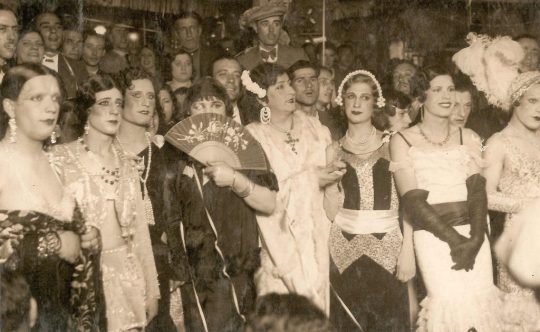
Contestants in the 1934 edition of "Miss Barri Xino" for crossdressers. Photo from the book La Criolla: la puerta dorada del Barrio Chino by Paco Villar.
The Barri Xino, nowadays more commonly known as Raval, is a working class neighbourhood of Barcelona, Catalonia's capital city. Being one of the poorest neighbourhoods in the city, it was the meeting place for people who were outside of the law or the morality of the time, including homosexuals and people who dressed in the way that is associated with the sex they were not assigned at birth (all called crossdressers at the time, this category would include a wide range of people including those we nowadays would call transgender, drag queens, homosexual men, sex workers, as well as thieves and other criminals who used women's clothes for their robberies on passerbies or for hiding). When referring to them, this post will use the term "crossdresser" in this broad meaning, as is used in the sources of the time and was used by the people we are talking about.
At the time, trans people and others who didn't want to follow the time's gender norms faced a lot of hardships. It was not uncommon for men to dress as women and viceversa during Carnival (annual holidays where people dress up, often with satirical purposes, considered a time of turning social convention upside-down) or for men to dress as women in theatre and concert halls. Even though these were situations where many found a place for self-expression and fun, the clothing transgression was limited to very specific ambits and often related to the arts or to things considered funny, but it wasn't normalized to freely exist on the streets outside of the Carnival period. In fact, traditions like Carnival (where the lower class rules and everyone makes fun of the Church and government, where the behaviours that aren't allowed the rest of the year or considered sinful are encouraged) or Saint Agatha's (where women get to form a government for 1 day a year) are found in many cultures around the world as an outlet in repressive societies, and are celebrated in a strongest and wildest way the more repressive their society is.

Carnival in Barcelona's Jardinets de Gràcia (richer area of the city), 1936. Photo from Arxiu Fotogràfic de Barcelona.


Photos of the parties that continued after King Carnestoltes's burial was over in Barcelona's Jardinets de Gràcia, 1935. Context: in Catalan culture, the Carnival holidays are personified in King Carnestoltes (King Carnival). On the last day of the Carnival period, the King is buried in a humourous event called "the burial of the sardine". For the burial, people of all genders dress as mournerers (the women who, often professionally getting paid for it, cry desperately at funerals) and the funeral procession parades on the streets exaggeratedly crying and wailing. Photos from Finestres de Memòria.
When talking about 1930s Catalonia, it's impossible not to mention anarchism, which was the mainstream political ideology of the Catalan working class. We must not assume that leftist movements gave support to queer liberation at the time, it clearly was not the case for most of the CNT and anarchism in general, who saw homosexuality and crossdressing as a bourgeois vice.
Outside of Carnival holidays, it wasn't normalized for people seen as men to walk on the streets wearing women's clothing. The most famous meeting place for those who wanted to wear them was the bar La Criolla, in the Barri Xino/Raval quarter. El Bataclan and El Sacristà were also frequented. Another common meeting place for some of them were the "vespasianes" (public urinals on the streets), where crossdresser AMAB people offered their services as sex workers or stole the wallet of the men who were distracted peeing. According to a witness, the people who crossdressed as women and attended the vespasianes and its surrounding areas were known as the carolines (les carolines). They are the protagonists of the 1933 march.
Sadly, we only have one source of information, so it's difficult to tell how accurate the explanation is. This source is the book Journal du Voleur ("Diary of a Thief") by Jean Genet, where he explains his experiences in Barcelona's crossdressing circles of the 1920s and 1930s when he was one of the crossdressers who stole from men peeing: a carolina. At the time, it was common for anarchists to bomb places frequented by the bourgeoisie, and sometimes other places, too. According to Genet, in 1933 one of these anarchist bombs ended up in one of these vespasianes urinals frequented by the carolines. This sparked one of the first documented queer marches, maybe encouraged by their bad relation with the anarchists.
Genet explains that the carolines were outraged at the destruction of the urinal, and that "[wearing] shawls, mantillas, silk dresses and fitted short jackets, they formed a solemn delegation to place a bouquet of red flowers tied with a gauze crape" on the destroyed urinal. They marched from Paral·lel avenue through Sant Pau street, down the Rambles until Colom statue shouting about what had happened.
Even though the Barcelona City Council talks about these events as true and Barcelona's LGBT associations call it "the first documented LGBT march in history", it's unknown how much of Genet's description is true. Genet was known for his proclivity to embellish and exaggerate real events and, after all, the only source of information is a literary work (memoir). There is no other recorded use of the word carolines to refer to these people, but precisely because of their marginalization it's not a demographic that was often talked about in newspapers or other historicals sources of the time.
Despite the lack of knowledge about the carolines's march specifically, the crossdressing meeting places are well-known, with many photos and witnesses of the time. We also know what happened next: in 1936, the fascists in the Spanish Army did a coup d'état which started the Spanish Civil War, ending with the fascist victory in 1939. About the bars where crossdressers and others used to meet, we know that La Criolla was destroyed by a fascist bomb in August 1938, during the war. Cal Sacristà (which had changed its name to Wu-Li-Chang in 1934) was also destroyed when the fascists were bombing the city. Bataclan was forced to change its name to Rataclán and ended up closing in 1942. The fascist dictatorship of Spain (1939-1978) imposed a strict Nationalcatholic morale and persecuted those who did not follow its strict gender roles (trans people, homosexuals, feminists), national minorities (like Catalans, Basques, Galicians), and political dissidents. The dictatorship even forbid Carnival for years, event though it's a holiday of the Catholic religion (Carnival is the excess before the fasting period of Lent). The only crossdressing that was legally allowed were transformist male artists who imitated famous female stars in theatres and concert halls, and even they had to be discreet. Their life on the streets was persecuted, but they never eliminated the presence of crossdressing in Raval. You can read more about homosexuality and crossdressing during the dictatorship in this previous post, about the Law of Social Danger in this one, about Catalonia's first Pride march (1977) in this one, and as always find out more about Catalan queer people and history in this blog's tag #uselesslgbtfacts.
Information sources: Transvestits en acció by Lluís Permanyer (in Catalan), La Revolta de les Carolines by Leopold Estapé (in Catalan), Vespasiana by Ailo Ribas (in English). A good explanation that helped me contextualize is found in this entry in La Barcelona Diversa (in Catalan).
#uselesslgbtfacts#història#barcelona#catalunya#carnaval#1930s#history#trans#pride#lgbt history#lgbtq history#queer history#queer#trans history#transgender history#gender non conforming#transgender#queer culture
187 notes
·
View notes
Text
flowers symbolization in the MCR videos (especially red carnations)

so i was looking back at MCR's videos and noticed these flowers. They show up pretty clearly in the last few seconds of the first video. so i thought to do some digging about them since i feel like every tiny detail counts in these videos LMAO. So these flowers are apparently red carnations and baby breath flowers. so i tried to look up symbolization regarding these flowers and found some stuffff
ok so apparently red carnations were worn during International Workers' Day known as May Day, which was a major celebration in the Soviet Union. May Day was a public holiday that celebrated the working class and the achievements of socialism. On this day, people would wear red carnations or carry them in parades and marches. Under Joseph Stalin however, May Day was a major event that showcased its MILITARY power, which is why the guy in the first video kind of looks like he's wearing some sort of military outfit IDK. Also under the Soviet Union, the government often ENFORCED participation in May Day parades to show solidarity and loyalty to the government. That kinda further proves the idea that the Black Parade is kind of being forced to stay in MOAT and show their solidarity to the DRAAG dictatorship. So, under the Soviet Union May Day parades became less against dictatorship (like they originally were) and more about loyalty to government and celebration of socialist achievements under the Soviet Union. I think what's going on in the first video might be some sort of reference to something like a May Day parade, espically with the caption: "His Grand Immortal Dictator wishes to celebrate our rich and storied culture, fine foods, and musical entertainments", this is in short what May Day was about under the Soviet Union. This all would make a lottt of sense. I really do not think this is a coincidence at all and in short, in the first video at least, I think the parade or march or whatever we hear going on outside might be something like a May Day parade.
oh yeah another thing, a popular slogan used during these Mayday parades was "Long Live the Dictatorship of the Proletariat." .... which sounds pretty familar righttt... to "Long Live Draag", which was the in the caption of the first video MCR posted. Another important detail i forgot to mention about the May Day parades is that they were also used as propaganda to showcase soviet power and unity. These parades were highly orchestrated with military demonstrations and symbolic marches. Using this information, it's pretty fair to assume that the "Long Live" Black Parade tour is a form of propaganda for the DRAAG dictatorship. but ok moving on the the white flowers.............
OK SO the white flowers are called "baby breath" and I couldn't find as specific of an example for them, but they generally represent innocence and purity, in some cultures its symbolizes unconditional love butttt they're also commonly used in funeral arrangements, representing eternal love for someone who has passed. This is especially true in Asian and Eastern cultures, where they're commonly used in honoring ceremonies as a symbol of respect and affection.
So, I'm honestly not sure what these two mean together but i really reallllyyyyy doubt that it's a coincidence that they were put together, especially with the symbolization of the red carnations. PLEASE TELL ME YOUR THOUGHTS ABOUT THIS BC I REALLY DONT THINK THE FLORAL ARRANANGMENT IS A COINCEDENCE AT ALLLL i just can't think of what they could mean together. Maybe the contrasting symbolization of the two flowers are significant in some way? idk plsss pls pls pls give me ur thoughts u guys are smart 😭😭😭😭😭
also im just now realizing how long all this is im sorry im so invested LMFAO
#mcr#mcr theory#mcr5 truthing#emo#frank iero#gerard way#mcr tumblr#ray toro#mcr the black parade#mcr5 is real#mcr5#my chemical romance#mikey way#the black parade#epic sauce for sure#draag#long live the black parade#long live draag
93 notes
·
View notes
Text
Okay, I'll talk more about Achilles, Patroclus and Antilochus. Why not? What I want to talk about here is how Philostrathus describes a supposed painting of the death of Antilochus (I say "supposed" because there is debate as to whether all the paintings described in Imagines actually existed or were literary devices). In such a short amount of time, he compartmentalizes a lot of what is special about these three and a few others (the other Achaeans, especially Menelaus).
Philostratus begins not with a description, but with a brief introduction, recapping who Antilochus is by using Homer. He reminds you, the reader, of how special Antilochus is to Achilles. He talks about how Menelaus asked Antilochus to give the news of Patroclus' death to Achilles, saying that it was intentional on Menelaus' part that Antilochus was chosen. Not only because of his speed, but for Philostratus it's also because Menelaus knew that Achilles would need him. And he did. Antilochus not only stopped him from killing himself by holding his hands, he also provided comfort. A comfort, as Philostratus says, "Achilles no doubts rejoices."
That Achilles loved Antilochus you must have discovered in Homer, seeing Antilochus to be the youngest man in the Greek host and considering the half talent of gold that was given him after the contest. And it is he who brings word to Achilles that Patroclus has fallen, for Menelaus cleverly devised this as a consolation to accompany the announcement, since Achilles’ eyes were thus diverted to his loved one; and Antilochus laments in grief for his friend and restrains his hands lest he takes his own life, while Achilles no doubt rejoices at the touch of the youth’s hand and at the tears he sheds.
Translation by Arthur Fairbanks.
You see, much is said of how inconsolable Achilles was in The Iliad. Much is said of his seemingly endless sadness and rage. But little is said of this moment of comfort. Short, but special. And we know it's special, given how commonly Antilochus has been referred to as a person dear to Achilles in the sources, second only to Patroclus. This is attested to as early as The Odyssey, when the ghost Agamemnon speaks of Achilles' funeral. And this comfort isn't just about Achilles, but about both of them. For, as Homer describes it, Antilochus was crying as he ran. Patroclus wasn't just important to Achilles, he was important to other people as well. Menelaus didn't defend his body "as a mother cow lows over her firstborn, knowing nothing before this of bearing young" (Caroline Alexander) just because it was cultural practice to recover bodies, just because Achilles needed Patroclus. It's because he is sad too, he cares too. When Automedon talks about how Patroclus could control the divine horses Xanthus and Balius, he isn't just talking about the loss of Patroclus' usefulness. He is mourning the loss of a companion, someone who had shared activities with him. And even the horses were in mourning, blaming themselves for the death of their Patroclus. It's the same with Antilochus. Antilochus, in comforting Achilles, is comforting himself. Because this loss is great for Achilles, but it isn't a grief that belongs only to him. Antilochus is saying "I understand you, I'm here." And just as Antilochus was there for his companion, Achilles was there for him.
And then Philostratus describes the death scene. And there are so many elements:
Now such is the scene in Homer, but the events depicted by the painter are as follows: Memnon coming from Ethiopia slays Antilochus who had thrown himself in front of this father, and he seems to strike terror among the Achaeans – for before Memnon’s time black men were but a subject for story – and the Achaeans, gaining possession of the body, lament Antilochus, both the sons of Atreus and the Ithacan and the son of Tydeus and the two heroes of the same name. The Ithacan is made known by his austere and vigilant look, Menelaus by his gentleness, Agamemnon by his god-like mien, while the son of Tydeus is marked by his nobility, and you would recognize the Telamonian Ajax by his grimness and the Locrian by his alertness. And the army mourns the youth, standing about him in lamentation; and, their spears fixed in the ground and their legs crossed, they stand, most of them in their grief bowing their sorrowing heads on their spears. You are not to recognize Achilles by his long hair, for that is gone since the death of Patroclus, but let his beauty make him known to you, and his stature, aye, and the very fact that he does not wear long hair. He laments, throwing himself on the breast of Antilochus, and he seems to be promising him a funeral pyre and the offerings to be placed upon it and perchance the arms and head of Memnon; for he proposes that Memnon shall pay all the penalties Hector paid, that in this respect also Antilochus may have no less honour than Patroclus had. Memnon, stands, terrible to look upon, in the army of the Ethiopians, holding a spear and wearing a lion’s skin and sneering at Achilles. Let us next look at Antilochus. He is in the prime of youth, just beyond the period of downy beard, and his bright hair is his pride. His leg is slender and his body proportioned for running with ease, and his blood shines red, like colour on ivory, where the spear-point penetrated his breast. The youth lies there, not sad of aspect nor yet like a corpse, but still joyous and smiling; for it was with a look of joy on his face (because, I fancy, he had saved his father’s life) that Antilochus died from the spear-thrust, and the soul left his countenance, not when he was in pain, but when gladness prevailed.
Translation by Arthur Fairbanks.
The characters are described by their reactions. You know who Menelaus is by the gentleness of his face, you know who Odysseus is by his watchful gaze. But when he describes Achilles, he says: "You are not to recognize Achilles by his long hair, for that is gone since the death of Patroclus, but let his beauty make him known to you, and his stature, aye, and the very fact that he does not wear long hair." You recognize Achilles by the loss of what he once was, represented by his hair. You know that the man with the clearly freshly cut hair is Achilles because that is the symbol of someone who has been in mourning. Someone who is in mourning right now, for the second time in a short time. And it's interesting to think about it. To think that Achilles' hair didn't even have time to grow back before Antilochus was gone too. Achilles couldn't even dream of dedicating his hair to Antilochus as he did to Patroclus because, with such a recent mourning, there wasn't even enough hair to do it. When Patroclus died, Achilles' balance died too. He was already violent and intense before, but anger and sadness like that had never been seen in him before. But when Antilochus died, the perception of comfort he had is what died. And Philostratus predicts that you're still imagining Achilles with his long hair. Yes, the epic Achilles of the battlefield. But this isn't the epic Achilles of the battlefield, he reminds you, this is a broken Achilles. This is someone who has lost two loved ones, someone who has lost Patroclus and Antilochus.
And as with Patroclus, Achilles won't bring him back. He killed Hector, but Patroclus was still a ghost. Achilles still couldn't embrace him, no matter how much he wanted to. According to the myth, Achilles killed Memnon because of Antilochus. And yet, Antilochus won't return. Like Patroclus, he is gone, never to return. But they will be reunited. Achilles isn't immortal, he is very mortal, he is destined for death. This is a con of his prophecy, where the pro is his undying glory. And yet, it's this negative point that will allow him to be with those he loves. Those who, like him, are mortal. Killing Hector and Memnon will feel empty, but will dying feel empty? When he sees Patroclus and Antilochus in the afterlife, will dying still feel empty?
But if, on the one hand, Patroclus in The Iliad died arrogantly when declaring to Hector that he could defeat him and when decreeing that he would soon die, Antilochus died… simply happy: "The youth lies there, not sad of aspect nor yet like a corpse, but still joyous and smiling; for it was with a look of joy on his face (because, I fancy, he had saved his father’s life) that Antilochus died from the spear-thrust, and the soul left his countenance, not when he was in pain, but when gladness prevailed". The idea of dying doesn't sadden him, not if it means that Nestor is alive. He is a son who values his father more than himself. This stark contrast in the way Achilles laments over his body, even momentarily abandoning the glory of the battlefield for it (note how Memnon is there and yet Achilles pays him no attention), while Antilochus himself is smiling…Philostratus knew what he was doing in this description.
And finally: "His leg is slender and his body proportioned for running with ease". It's said when describing Antilochus. Just a reminder that, like Achilles, he was a runner. Just as this whole scene is a reminder that, like Patroclus, he was a companion and someone to be mourned. Patroclus is often thought of as a kind of complement to Achilles, especially in the shared armor episode. But I think Antilochus is too, he reflects both Patroclus and Achilles.
59 notes
·
View notes
Text

Back to Sailor Moon for the floriography series! First up is Saturn! 🪐
The flower I chose for Saturn is the white chrysanthemum. White chrysanthemum flowers are commonly used in funerals in East Asian and some European cultures, and is associated with death, bereavement, and condolence. However in Chinese culture it is also associated with the traditional Double Nine Festival, a festival that celebrates one’s ancestors and during which people pray for health and a good harvest. In that context, chrysanthemums, and wines made from the flower, are associated with health and longevity. The two paradoxical meanings is a nice fit for Saturn, the herald of death but also of rebirth.
190 notes
·
View notes
Text


2,500-Year-Old Greek-Illyrian Helmet Discovered in Croatia
Archaeologists discovered a Greek-Illyrian helmet dating 2,500 years in very good condition on Croatia’s Pelješac peninsula.
The same team that found the Greek-Ilyrian helmet in 2020, in the same place, has found the next helmet, which according to the first analysis is older than the one found earlier.
The previous example most likely belonged to a member of the warrior elite who was interred there because it was discovered in a grave with pieces of iron weapons.
Archaeologists think the recently discovered helmet may have been a votive deposit because it was discovered in a dry stone-walled addition to a grave.
Greco-Illyrian type helmets originated in Peloponnese, Ancient Greece, where it likely evolved from the Kegelhelm (or Kegel type) of the Archaic Period.
The Greek-Illyrian helmet is extremely rare
Both of the helmets found are of different types and dates: The helmet discovered in 2020 was of a type commonly used in Greece and Illyria in the 4th century BC. It was an open-faced helmet with a rectangular cross-section for the face and decorative edges.
The newly found helmet is thought to date from the 6th century BC and is extremely rare. Finding two different Greek-Illyrian helmets at one site is unprecedented.
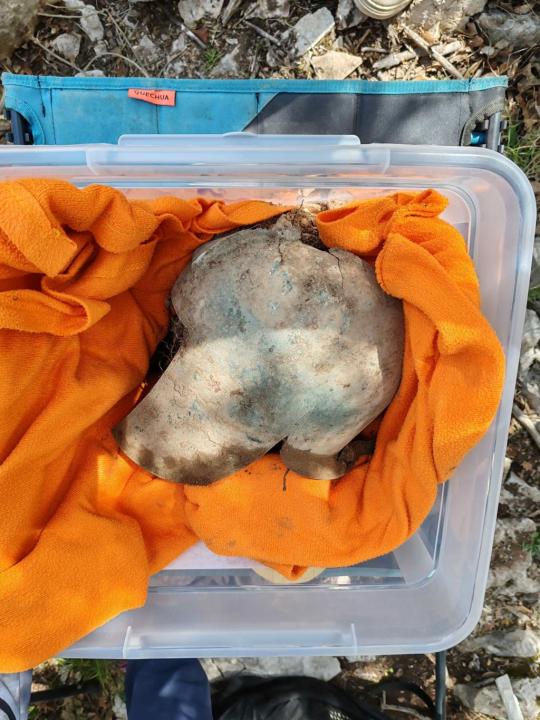
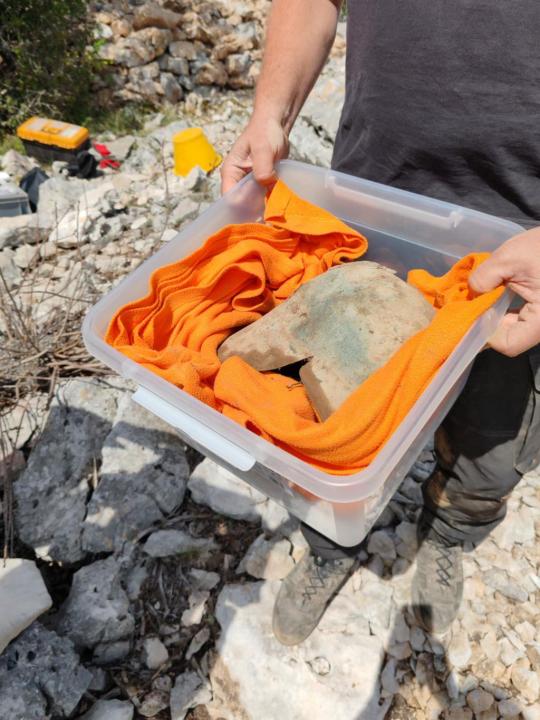

This find, along with a wealth of clothing, jewelry, and burial artifacts unearthed since the excavations began, greatly expands our knowledge of the funeral practices of Illyrian communities in the latter half of the first millennium BC.
The Illyrians were a group of Indo-European-speaking people who inhabited the western Balkan Peninsula in ancient times. They constituted one of the three main Paleo-Balkan populations, along with the Thracians and Greeks.
“What is very interesting is that two different types appear here in the same place, which speaks of a continuity of power of the respective community. These helmets have always been a symbol of some kind of status and power,” said Professor Hrvoje Potrebica, from the Department of Archeology of the Faculty of Philosophy in Zagreb.



Speaking on the discovery, a representative from the Dubrovnik Museum said: “Along with numerous finds of jewelry, costumes and grave goods, this find of a helmet contributes in many ways to the knowledge of funeral rituals of Illyrian communities in the second half of the last millennium BC, and it ranks the area of Pelješac as one of the most important archaeological zones of the eastern Adriatic coast.”
Recently, archaeologists in Southern Italy have unearthed several significant artifacts, including two helmets, fragments of weapons and armor, and pottery shards, at an archaeological site in the ancient Greek city of Velia.
By Tasos Kokkinidis.
#2500-Year-Old Greek-Illyrian Helmet Discovered in Croatia#ancient Greek city of Velia#ancient artifacts#archeology#archeolgst#history#history news#ancient history#ancient culture#ancient civilizations#greek history#greek art
283 notes
·
View notes
Text
The way that the flowers associated to Sua and Ivan are lillies and anemones, flowers that are commonly used for both weddings and funerals, when R1 and R6 were practically a 2 in 1 ceremony where they both "married" Mizi and Till respectively and died leaveing the other mourning as a grieving widow


#sua alnst#sua alien stage#alnst sua#alien stage sua#alnst ivan#ivan alien stage#ivan alnst#alien stage ivan#alien stage#alnst
75 notes
·
View notes